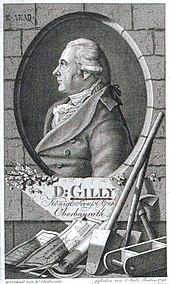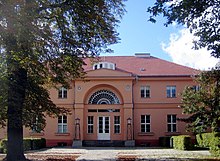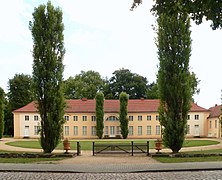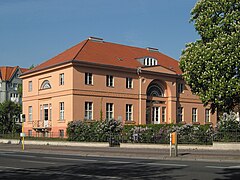David Gilly

David Gilly [ ʒiˈli ], completely David K. Friedrich Gilly, (born January 7, 1748 in Schwedt ; † May 5, 1808 in Berlin ) was a German architect , town and regional planner and building designer at the beginning of the classicism era .
family
Gilly came from a Huguenot family from the Nîmes area , who had settled in French Buchholz near Berlin in 1689 . In 1770 David Gilly married Friederike Ziegenspeck (1748–1804), the daughter of a regimental stable master . The couple's son was the future architect Friedrich Gilly , the daughter Minna (* 1774) married the politician Friedrich Gentz , a brother of the architect Heinrich Gentz . After the death of his wife in 1804, David Gilly married his sister-in-law Juliane in 1805.
Life
Teaching and beginnings in Pomerania
At 13 Gilly 1761 joined as an apprentice to his apprenticeship at Neumark Country Planning Director Ludwig Hahn. He became in 1763 the reconstruction of Küstrin and Zantocher suburbs of Landsberg on the Warta used and 1,766 in the amelioration of the Warthe and networks breaks under Franz Balthasar Schönberg from Brenkenhoff . On his recommendation, Gilly passed the aptitude test on August 4, 1770 with the newly established senior examination committee at Boumann in Berlin and was appointed master builder in the Pomeranian Altdamm (now a district of Stettin) just five days later . From there, he headed the lowering of the Plöne carrying Madüsees and the establishment of Kolonistenbauten. In 1771 he married Friederike Ziegenspeck, who gave birth to a son, Friedrich, on February 16 of the following year.
In 1772 Gilly took over a district of his own in Stargard and in 1776 was assigned the supervision of all three Pomeranian districts as the chief building director.
Senior Building Director in Pomerania
It was not until 1782 that Gilly moved to the provincial capital of Szczecin , promoted to senior construction director . He was responsible for all publicly financed construction and agricultural measures in Pomerania: the expansion of the piers and port facilities in Swinoujscie , the load areas in Szczecin and Kolberg , the new planning and construction of the burned down towns of Jakobshagen and Zachan and the expansion of the inner-city water supply in Szczecin. His tasks included the development of standardized housing and stables, warehouses, barns and factories for rural and small-town settlements as well as the preparation of reports and expertises on amelioration for King Frederick the Great .
In Berlin

In March 1788, he was appointed to the secret building councilor and appointed to the royal building department in Berlin. Gilly was responsible for the management of the state construction of the provinces of Pomerania, East and West Prussia . After the second and third partitions of Poland in 1793/95, Gilly held the office of South Prussia in addition to Pomerania . During these years he was responsible for the construction of the Bydgoszcz Canal , the renovation and expansion of the port facilities in Danzig and Elbing and the new construction of the cadet institution in Kalisch .
Gilly had already started drawing maps around 1760. In 1789 a map of Western and Eastern Pomerania appeared in six sections and in 1802/03 one of South Prussia in 13 sections. The cards were engraved by Daniel Friedrich Sotzmann .
Gilly fulfilled not only the state but also numerous private orders for the construction of manor houses and facilities. The ensemble of palace, park and garden architecture, commercial and residential buildings created for the Oberhofmarschall and artistic director of the royal castles Valentin von Massow in Steinhöfel caught the attention of the Crown Prince couple Friedrich Wilhelm and Luise . They commissioned Gilly to redesign the village complex of Paretz and to build Paretz Castle as a summer residence in 1796/97 without any traditional forms of dignity . After his accession to the throne in 1798, Friedrich Wilhelm appointed Gilly Vice Director of the Oberhofbauamt .
In the years around 1800 Gilly reached the peak of his work. While his buildings in Pomerania were still characterized by the transition from a late Baroque style to the plait style , from the 1790s onwards, under the influence of his son, he found a simple classicism that approached revolutionary architecture. Characteristic were symmetrical and functional buildings with smooth, rhythmic and sparingly ornamented facades, often with a flat "thermal bath window" emphasizing the center . In contrast to the older Carl Gotthard Langhans , who clung to the high baroque roof shapes (such as the Charlottenburg Palace Theater around 1790, the National Theater on Gendarmenmarkt 1800–1802 and the Kehnert Manor from 1803), Gilly's roofs were classically flat as early as the 1790s. His style prevailed in the construction of public buildings in the central and eastern provinces of Prussia and also influenced private building.
In Paretz, Gilly created the first examples of neo-Gothic in Germany with the Gothic house , the forge and later restaurant, and the remodeling of the church, which was essentially medieval .
Gilly was a member of the Berlin Masonic Lodge To the Three Golden Keys .
Teacher and publicist
David Gilly had become a member of the Royal Prussian Academy of Arts and Mechanical Sciences in 1790 . In order to train qualified offspring in the building trade, in 1793 he founded, together with younger members of the Oberbaudepartement in Berlin and his son Friedrich, a “private educational institution for friends of architecture”, which however had to close in 1796. Only after Friedrich Wilhelm III took office. began in 1799, the circle of education reformers to the next Gilly, since 1798 the second director of the Upper Building Department, the architects and Baupraktiker John Albert Eytelwein , Friedrich Becherer , Heinrich August Riedel , Carl Gotthard Langhans and Minister Friedrich Leopold von Schrötter and Friedrich Anton von Heynitz included , the establishment of the Berlin State Building Academy . Gilly taught the subject of hydraulic engineering and dyke engineering and was one of its annually changing directors.
As a teacher and publicist, Gilly made a name for himself in spreading cost-saving building ideas such as the plank truss roof and the Pisé construction . He was the main author of the Handbook for Landbaukunst 1797/98, which propagated the modernization of agricultural buildings, and of the magazine Collection of useful articles and news about architecture for prospective builders and friends of architecture published by the Oberbaudepartement . It was the first architecture magazine published in Germany and also reported on current English and French articles on architecture and construction.
Last years
For Gilly the death of his son Friedrich in 1800 and three or four years later that of his wife and daughter were severe blows. His creativity slackened, but he built several manor houses and redesigned existing buildings. A three-month study trip to Paris in 1803/04 with his pupil August Crelle and Leo von Klenze , who was probably also his student , had no consequences .

As a result of the enormous decline in state revenues after the Peace of Tilsit , the Prussian state could no longer pay the officials of the Oberbaudirektion, the Oberhofbauamt and the Bauakademie from 1807. His shortened by 80% remuneration had to Gilly for the billeting use of French officers in his Berlin home.
At the age of 60, David Gilly died, seriously ill and impoverished, on May 5, 1808 in Berlin. He was buried in Cemetery II of the Jerusalem and New Church Congregation in front of the Hallesches Tor in Berlin in a tomb he built himself. The grave, rediscovered in 1937, has been dedicated to the State of Berlin as an honorary grave since 1952 by decision of the Berlin Senate . The dedication was extended in 2016 by the usual period of twenty years.
Buildings (selection)
- 1783 Conversion of the Jasenitz Palace near Stettin into the summer house of Lisbeth von Stettin (not preserved)
- 1783 Petrihospital Stettin (demolished in 1891)
- 1787 Establishment of rooms in the Szczecin Palace for the government and Princess Elisabeth (not preserved)
- 1788/1792 Church in Swinoujscie (rebuilt in neo-Gothic style in 1881, preserved)
- 1790 Schloss , Gut and Park Steinhöfel (Gilly's castle building completely changed, parts of the manor complex (office building, residential buildings) and the park buildings (library) preserved, open to the public)
- 1792 Stobingen-Ripkeim manor (since 1946 Liwny) near Wehlau for Friedrich Leopold von Schroetter (fell into disrepair after 1945, still preserved as a ruin in 1993)
- 1797 Paretz palace and village complex (after 1945 inappropriately used and disfigured, restored in 1999/2001 and accessible to the public)
- 1798 redesign of the pleasure garden in Berlin ( greatly modified by Lenné in 1828 )
- 1798 Freienwalde Palace for Queen Friederike Luise of Prussia (preserved with slightly modified facade)
- 1799 Vieweg House in Braunschweig , residence and publishing house for Friedrich Vieweg ( open to the public as Braunschweigisches Landesmuseum )
- 1799/1800 Neu-Kladow , mansion, built for the royal cabinet secretary Anastasius Ludwig Mencken (grandfather Otto von Bismarcks ), remodeled 1910–11 by Paul Schultze-Naumburg
- 1800 dairy farm in the park of Bellevue Palace in Berlin, started by the son (1945 ruin, then demolished)
- 1803 Machnow manor in Kleinmachnow for the von Hake family (burnt out in 1943, demolished in 1950)
- 1803 Spandau prison (demolished in 1897)
- 1804 Steglitz manor for Carl Friedrich von Beyme (planning), completed by Heinrich Gentz (publicly used since 1995 after dismantling later changes)
- 1805 Gütergotz Castle for the Berlin lottery entrepreneur Grothe (changed beyond recognition in the course of the 19th century, preserved)
- 1806 Reconstruction of Palais Wilhelmstrasse 65 in Berlin for Prince August Ferdinand , completed by Paul Ludwig Simon . By Karl Friedrich Schinkel in 1815 and 1817 for Prince August jr. and Karoline Friederike von Waldenburg rebuilt and equipped (Schinkel-Saal), 1844 to the Prussian state as Prussian Ministry of Justice, from 1935 Reich Ministry of Justice (burned out in 1945, ruin demolished in 1950)
Freienwalde Castle , 1798
Vieweg House , Braunschweig, 1799
Kleinmachnow manor house , 1803
Steglitz manor house , 1804
Fonts
- Description of the fire-retarding clay shingle roofs: along with collected news and experiences about the construction with dried clay bricks. Königliche Hofbuchdruckerey, Berlin 1794, digitized
-
Ground plan for the lectures on the practical with various subjects of hydraulic engineering. Realschule bookshop, Berlin 1795
- New increased and improved ... edition, Realschulbuchhandlung, Berlin 1801, digitized
- Continuation of the depiction of land and hydraulic engineering in Pomerania, Prussia and part of the New and Kurmark, broken off in the third volume on page 10 . In: Preußisches Ober-Bau-Departement (Hrsg.): Collection of useful essays and news relating to architecture . Zweyter Theil, Unger, Berlin 1798, pp. 3-16.
- On the invention, construction, and advantages of plank roofs. Friedrich Vieweg the Elder Ae., Berlin 1797, digitized
-
Handbook of Land-Bau-Kunst, especially with regard to the construction of residential and commercial buildings; for budding cameral builders and economists, in 3 parts. (Volumes), doi: 10.3931 / e-rara-12154
- 1st part, construction of the residential and commercial buildings. , Friedrich Vieweg, Berlin 1797
- 2nd part, construction of the residential and commercial buildings. , Friedrich Vieweg, Berlin 1798
- (after the death of D. Gilly) D. [Daniel] G. [Gottlob] Friderici (Ed.): 3rd part, instructions for agricultural architecture. , 1st and 2nd department, Rengersche Buchhandlung, Halle 1811
-
Copper collection for the handbook of land-building-art: excellent in consideration of the construction of the residential and commercial buildings for prospective camera builders a. Economists.
- Volume 1, Friedrich Vieweg, Braunschweig 1820, doi: 10.11588 / diglit.4659
- Volume 2, Rengersche Buchhandlung, Halle 1821, doi: 10.11588 / diglit.4660
- with Johann Albert Eytelwein : Brief instructions on how lightning rods are to be attached to the buildings. Berlin 1798, digitized
- Outline of cameral building science designed for lectures. Realschule bookstore, Berlin 1801, digitized
- Practical instruction on the use of leveling or water weighing in the most common cases of the national culture. Georg Decker, Berlin 1800, digitized
- About the foundation of the building on bricked wells. Realschule bookstore, Berlin 1804, digitized
editor
- Collection of useful articles and news on architecture. 1.1797- [4th] 1800; 5.1803-6.1805 / 06; Berlin
- with Johann Albert Eytelwein : Practical instruction on hydraulic engineering , which contains instructions for designing, estimating and executing the most commonly occurring hydraulic structures. 1st edition doi: 10.3931 / e-rara-19445 , 2nd edition doi: 10.3931 / e-rara-9252 , 3rd edition urn : nbn: de: bsz: 14-db-id3372684011
- 1st booklet, Of the stakes, the rams and the cofferdam. (1802, 1809, 1830)
- 2. Booklet, From the machines for scooping out the water from the foundation.
- 3rd booklet, Of the bulwarks and lining walls.
- 4th issue, On the construction of the shipping locks.
Translations
- Johannes Samuel Creutz: Comparison of the different types of construction which are used when the works built in the sea were founded, but especially when the port walls or the so-called moles at the sea ports are performed. (Translated from the French and accompanied by a few notes), Königl. Go Hofbuchdruckerey, Berlin 1796, digitized
literature
- Monument of love and admiration: dedicated to her immortalized teacher Mr. David Gilly ... by the student members of the Royal Building Academy in Berlin. Berlin 1808.
- Hermann Schmitz : Berlin master builder from the end of the eighteenth century . Verlag für Kunstwissenschaft, Berlin 1914, pp. 34–38 ( Textarchiv - Internet Archive ).
- Adolph Doebber : Gilly, David . In: Ulrich Thieme , Fred. C. Willis (Ed.): General lexicon of visual artists from antiquity to the present . Founded by Ulrich Thieme and Felix Becker . tape 14 : Giddens-Gress . EA Seemann, Leipzig 1921, p. 48 ( Textarchiv - Internet Archive ).
- Alste Horn-Oncken: Gilly, David. In: New German Biography (NDB). Volume 6, Duncker & Humblot, Berlin 1964, ISBN 3-428-00187-7 , p. 399 ( digitized version ).
- Marlies Lammert: David Gilly. A builder of German classicism . Akademie-Verlag, Berlin 1964. 2nd unchanged edition (= The Buildings and Art Monuments of Berlin Supplement 6), Gebr. Mann, Berlin 1981, ISBN 3-7861-1317-3 .
- Gottfried Loeck: David Gilly's contributions to the development of the cartography of Pomerania . In: Baltic Studies NF 76, Marburg 1990, pp. 134–148.
- Andreas Kahlow (Ed.): About the beautiful and the useful. David Gilly (1748-1808) . Exhibition catalog, Prussian Palaces and Gardens Foundation Berlin-Brandenburg, Berlin 1998.
- E. Wätjen: Gilly, David . In: General Artist Lexicon . The visual artists of all times and peoples (AKL). Volume 54, Saur, Munich a. a. 2007, ISBN 978-3-598-22794-3 , pp. 225-228.
- Anna Teut: David Gilly 1748–1808: A Prussian master builder. Life - work - effect . Accompanying document to the exhibition, Berlin 2008.
- Eduard Führ, Anna Teut (Ed.): David Gilly - Renewer of building culture . Waxmann, Münster 2008, ISBN 978-3-8309-2054-0 .
- Marcel Piethe: The Brandenburg builder David Gilly and the art of agriculture in the 18th century . In: Die Mark Brandenburg , Heft 69, Berlin 2008, pp. 18-27.
- Sabine Bock : Gilly, David (1748–1808). In: Dirk Alvermann , Nils Jörn (Hrsg.): Biographisches Lexikon für Pommern . Volume 1 (= publications of the Historical Commission for Pomerania. Series V, Volume 48, 1). Böhlau Verlag, Cologne / Weimar / Vienna 2013, ISBN 978-3-412-20936-0 , pp. 97-99.
- Tim S. Müller: Durability, convenience and beauty. David Gilly's Handbook of Land-Building Art from an Environmental-Historical Perspective . In: History of Technology , Volume 76, 2009, Issue 2, pp. 83-103.
- David Gilly. In: Hermann Schmitz : Berlin builders from the end of the eighteenth century . 1914
Web links
- Literature by and about David Gilly in the catalog of the German National Library
- Works by and about David Gilly in the German Digital Library
- David Gilly exhibition in Bad Freienwalde and Braunschweig
- Tribute to Gilly by the city of Schwedt.
- Güterfelde Castle: the essence of Gilly's architecture . Information from the blogwohnmal.info about Gütergotz Castle
Individual evidence
- ^ E. Wätjen: David Gilly , p. 226.
- ↑ Proof of membership ( memento from April 17, 2016 in the Internet Archive ).
- ↑ Published by Decker in Berlin under the title: Handbuch der Land-Bau-Kunst. Excellent in regard to the construction of the residential and commercial buildings for budding cameral builders and economists . After Gilly's death with a third supplementary volume (on the layout of entire buildings ... in consideration of their construction and on the Pisé construction method and on clay clapboard roofs as well as on barns, wagon and wood sheds, poultry, pig, cattle and horse stables and finally on the Layout of the brewery and distillery building ) published by Gilly's employee DG Friderici at Renger, Hall 1811.
- ↑ Gilly described the personal situation on the day of his death in a letter to King Friedrich Wilhelm; Wording in Schmitz 1914, p. 37.
- ^ Hans-Jürgen Mende : Lexicon of Berlin burial places . Pharus-Plan, Berlin 2018, ISBN 978-3-86514-206-1 , p. 232.
- ↑ Honorary graves of the State of Berlin (as of November 2018) . (PDF, 413 kB) Senate Department for the Environment, Transport and Climate Protection, p. 26; accessed on March 25, 2019. Recognition and further preservation of graves as honorary graves of the State of Berlin . (PDF, 205 kB). Berlin House of Representatives, printed matter 17/3105 of July 13, 2016, p. 1 and Annex 2, p. 4; accessed on March 25, 2019 ..
- ↑ Hellmut Hannes : From the history of the Christ Church in Swinemünde . In: Pomerania. Journal of Culture and History. Issue 4/2011, ISSN 0032-4167 , pp. 24-29.
| personal data | |
|---|---|
| SURNAME | Gilly, David |
| ALTERNATIVE NAMES | Gilly, David K. Friedrich |
| BRIEF DESCRIPTION | German architect and builder in Prussia |
| DATE OF BIRTH | January 7, 1748 |
| PLACE OF BIRTH | Schwedt |
| DATE OF DEATH | May 5, 1808 |
| Place of death | Berlin |








